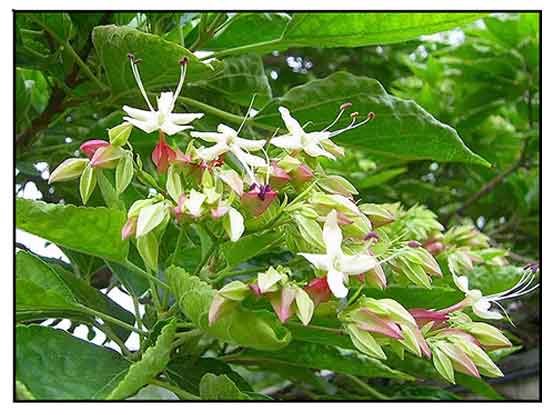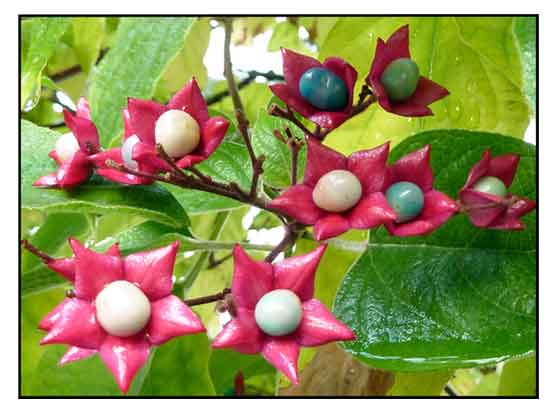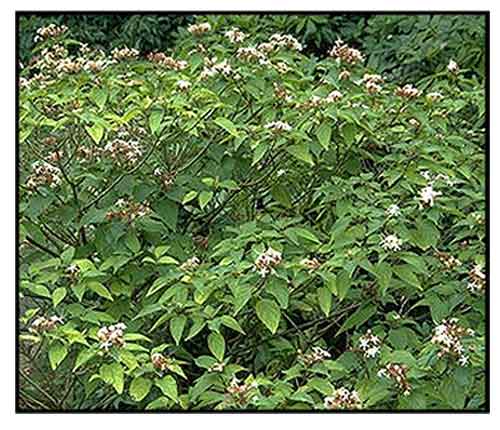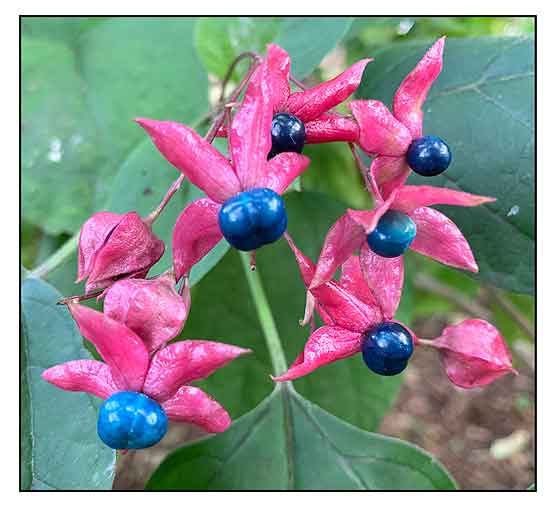 Gen info Gen info
- Clerodendrum is a genus of flowering plants formerly in the family Verbenaceae, but transferred to Lamiaceae (mint family) in the 1990s, based on phylogenetic analysis of morphological and molecular data. As of 2022, Plants of the World Online recognizes 258 species in the genus. (4)
-
Clerodendrum trichotomum is a species of flowering plant in the family Lamiaceae.
- It is cultivated for its fragrant flowers, autumn color, and ornamental berries. (3)
- The variety C. trichotomum var. fargesii (Farges' harlequin glorybower) and the cultivar C. trichotomum var. fargesii 'Carnival' have gained the Royal Horticultural Society's Award of Garden Merit. (3)
- Etymology: The genus name Clerodendrum derives from Greek words cleros meaning "chance or fate" or "clergy" and dendron meaning "tree". The species epithet trichotomum is also Greek, meaning "three-forked" or "triple-branched". (3)
 Botany Botany
• Shrubs or small trees, 1.5–10 m tall. Branchlets lenticellate. Petiole 2–8 cm; leaf blade greenish abaxially and dark green adaxially, ovate-elliptic, triangular-ovate, or ovate, 5–16 × 2–13 cm, papery, base broadly cuneate, truncate, or rarely cordate, margin entire or rarely undulate, apex acuminate, veins 3–5 pairs. Inflorescences axillary or terminal, lax, corymbose cymes, dichotomous, 8–18 cm; peduncle 3–6 cm; bracts elliptic, deciduous. Flowers fragrant. Calyx greenish, becoming purple, deeply 5-lobed; lobes triangular-lanceolate to ovate, acute. Corolla white or pinkish, ca. 2 cm, tube slender; lobes oblong, 5–10 × 3–5 mm. Style shorter than stamens, both exserted. Drupes blue-purple, subglobose, ca. 6–8 mm in diam. (2)
• Clerodendrum trichotomum is a large deciduous shrub, growing 3–6 metres (10–20 ft) high. The leaves are ovate, up to 12 cm (5 in) long, soft and downy or hairy, producing a peanut odor when crushed. Fragrant flowers are borne on branching peduncles. Petals are white, held within a green calyx, which turns red as the fruits ripen. Fruits (drupes) are white, changing to bright blue and eventually dark blue on maturity, and yields a novel blue pigment trichotomine. (3)
Distribution
- Native to the Philippines.
- Also native to
China North-Central, China South-Central, China Southeast, Hainan, Japan, Korea, Manchuria, Philippines, Qinghai, Taiwan. (1)
 Constituents Constituents
- Study of leaves isolated a series of cyclohexylethanoids, incuding two new compounds, 1-hydroxy-1-(8-palmitoyloxyethyl) cyclohexanone  (1) and 5-O-butyl cleroindin D (2), together with five known ones, rengyolone (3), cleroindin C (4), cleroindin B (5), rengyol (6) and isorengyol (7). (see study below) (7)
- Study of stems isolated nine abietane diterpenoids (1-9) from stems of C. trichotomum. Structures were identified as Villosin C (1), Villosin B (2), cyrtophyllone B (3), uncinatone (4), teuvincenone B (5), sugiol (6), teuvincenone F (7), teuvincenone A (8), and teuvincenone H (9). (see study below) (9)
- Study of n-butanol extract of stems of C. trichotomum isolated two new abietane diterpenoids: (4S, 5S, 10S)-12-(β-D-glucopyranosyl)oxy-11-hydroxyabieta-8,11,13-triene-19-oic acid β-D-glucopyranosyl-(1→6)-β-D-glucopyranosyl ester (1) and (3S, 5S, 10S, 15S)-3β-[β-D-glucopyranosyl-(1→6)-β-D-glucopyranosyl]oxy-12-(β-D-glucopyranosyl)oxyabieta-8,11,13-triene-11,16-diol (2), along with 5 known terpene glycosides (3–7). (see study below) (11)
- Phytochemical screening yielded reducing compounds ++, glycosides ++. polyphenols ++, quinones ++, and flavonoids ++, with absence of alkaloids and saponins. (13)
- Study of C. trichotomum isolated seven phenylpropanoid glycosides: acteoside (1), acteoside isomer (2), leucosceptoside A (3), plantainoside C (4), jionoside D (5), martynoside (6) and isomartynoside (7).
(see study below) (14)
- Study of C. trichotomum roots isolated 12 new abietane diterpenoids (1-21) and 31 known analogues (13-43). (see study below) (15)
Properties
- Leaves considered analgesic, antipruritic, sedative, hypotensive.
-
Studies have suggest antihyperuricemic, antioxidant, anticancer, hypotensive properties.
Parts used
Roots, leaves, seeds.
 Uses Uses
Edibility
- Young sprouts and leaves are edible; cooked.
-
In Nepal, the Yakkha community mix young leaves with rice and cooked as vegetable soup, used as blood pressure lowering food item.
Folkloric
- A folk medicine used for treatment of hypertension, arthritis, rheumatoid arthritis, and rheumatic problems.
- Decoction of roots and leaves used for treatment of rheumatism and hypertension.
- Leaves used externally for treatment of dermatitis and internally for treatment of hypertension, rheuumatism, numbness, and paralysis.
- Pounded seeds used to kill lice.
- In Nepal, leaves cooked with rice and eaten for blood pressure lowering effect. Powdered shoots taken daily for treatment of high blood pressure. (13)
Others
- Pigment: The fruits yield a sky-blue pigment when they ripen, which was used to color clothes in sky-blue, and studied for used as food color. (11)
Studies
• Antihyperuricemic / Leaves: Study evaluated the preventive effect of C. trichotomum leaf extract in hyperuricemia induced by potassium oxonate (PO) in mice. The extract at 400 mg/kbw significant reduced serum uric acid, blood urea nitrogen (BUN), and serum creatinine levels and increased urinary uric acid and creatinine levels. The extract ameliorated PO-induced inflammation and apoptosis by reducing levels of relevant proteins in kidney tissues, ameliorated both UA-induced inflammatory response in RAW263.7 cells and UA-induced cytotoxicity in HK-2 cells. Extract also enriched genes for mediating positive regulation of MAPK cascade and apoptotic signaling pathways. Results suggest the extract effectively prevents hyperuricemia and associated inflammation in PO-induced mice. (5)
• Cytotoxic Steroids against HeLa Cell Line / Leaves: Study of leaves isolated five new (2-16) and two known (1 and 7) steroids. Steroids 2 and 5 exhibited moderate in vitro cytotoxicity against HeLa cell line. (6)
• Cytotoxicity against A549 Human Tumor Cell Line / Leaves: Study of leaves isolated a series of cyclohexylethanoids, including two new compounds, 1-hydroxy-1-(8-palmitoyloxyethyl) cyclohexanone  (1) and 5-O-butyl cleroindin D (2), together with five known ones, rengyolone (3), cleroindin C (4), cleroindin B (5), rengyol (6) and isorengyol (7). Compounds 1 and 2 were evaluated for cytotoxicity against A549 human tumor cell line. (7)
• Improvement of Metabolic Derangements in High Fructose-Diet / Leaves: Study evaluated the effect of Ct leaf extract on the metabolic derangements induced in Sprague-Dawley rats by high-fructose (HF) diet. The Ct extract alleviated HF diet-induced insulin resistance, dyslipidemia, and hepatic steatosis. In liver tissues, Ct affected signaling pathways of AMP-activated protein kinase, peroxisome proliferator-activated receptor α (PPARα), sterol regulatory element binding protein 1. Ct enriched genes that may be involved in cytokine-cytokine receptor interaction, PPAR-P13Akt signaling pathways, and fatty acid metabolism pathway. Study suggest a promising therapeutic against metabolic disorders. (8)
• Cytotoxicity against Cancer Cell Lines / Abietane Diterpenoids / Stems: Study of stems isolated nine abietane diterpenoids (1-9) from stems of C. trichotomum. Structures were identified as Villosin C (1), Villosin B (2), cyrtophyllone B (3), uncinatone (4), teuvincenone B (5), sugiol (6), teuvincenone F (7), teuvincenone A (8), and teuvincenone H (9). All isolated were tested for cytotoxicity against four cancer cell lines: A549, HepG2, MCF-7, and 4T1. Compounds 1, 2, 3, 4, and 8 showed remarkable cytotoxic effects with IC50s ranging from 8.79 to 35.46 µM. (see constituents above) (9)
• Effects on Blood Pressure and Renal Function: Study evaluated the effect of the plant on blood pressure and renal function in rats. IV administration of the extract elicited renal vasodilation and increased urine flow and urinary sodium excretion. Acute oral administration of the extract reduced blood pressure of spontaneously hypertensive rats but not of normotensive control rats. Chronic administration for 6 weeks prevented increased in blood pressure of spontaneously hypertensive rats. (10)
• New Abietane Diterpenoids / Stems: Study of n-butanol extract of stems of C. trichotomum isolated two new abietane diterpenoids: (4S, 5S, 10S)-12-(β-D-glucopyranosyl)oxy-11-hydroxyabieta-8,11,13-triene-19-oic acid β-D-glucopyranosyl-(1→6)-β-D-glucopyranosyl ester (1) and (3S, 5S, 10S, 15S)-3β-[β-D-glucopyranosyl-(1→6)-β-D-glucopyranosyl]oxy-12-(β-D-glucopyranosyl)oxyabieta-8,11,13-triene-11,16-diol (2), along with 5 known terpene glycosides (3–7). All compounds were tested for cytotoxicity against cultured K562, MCF-7, A549, and HepG2 cell lines. None showed good antitumor activities. (12)
• Antibacterial / Antioxidant / Stems: Study evaluated five medicinal plants used by one ethnic group in Nepal for phytochemmical, antimicrobial, and antioxidant properties. The ethanol extract of C. trichotomum and methanol extract of Boehmeria platyphylla showed highest antibacterial and antioxidant activities, respectively. (13)
• HIV-1 Integrase Inhibitory Phenylpropanoid Glycosides: Study of C. trichotomum isolated seven phenylpropanoid glycosides: acteoside (1), acteoside isomer (2), leucosceptoside A (3), plantainoside C (4), jionoside D (5), martynoside (6) and isomartynoside (7). Compounds 1 and 2 showed potent inhibitory activities against HIV-1 integrase with IC50s of 7.8 and 13.7 µg, respectively. (14)
• Abietane Diterpenoids / NO Inhibitory Activity / Roots: Study of C. trichotomum roots isolated 12 new abietane diterpenoids (1-21) and 31 known analogues (13-43). Eight diterpenoids, 15,16-dehydroteuvincenone G (1), trichotomin A (4), 2α-hydrocaryopincaolide F (7), villosin C (20), 15-dehydro-17-hydroxycyrtophyllone A (22), demethylcryptojaponol (38), 6β-hydroxydemethylcryptojaponol (39), and trichotomone (43), exerted inhibitory effects against NO production with IC50 values of 5.6–16.1 μM. (15)
Availability
Wild-crafted.
|

![]()





 Constituents
Constituents
